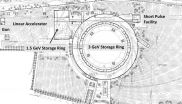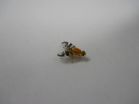A group of researchers from Texas believes that this discrepancy in soundscape may be contributing to rhinos' difficulties thriving and reproducing in captivity. During the 168th Meeting of the Acoustical Society of America (ASA), which will be held October 27-31, 2014, at the Indianapolis Marriott Downtown Hotel, they will present their acoustical analysis of a captive rhinoceros habitat, a first step towards understanding the impact of noise on these endangered animals.
Though zoologists have studied the impact of factors like diet and hygiene on rhino reproductive health, sound has been largely ignored. However, rhinoceroses have some of the keenest senses of hearing in the animal kingdom, able to perceive infrasonic sounds below the frequency range of human range of hearing. In the wild, they can sense predators coming from miles away by the vibrations their footsteps send through the ground. Because rhinos are so sensitive, noise that humans don't notice – or can't even hear – could be distressing and disruptive to them, negatively impacting their health, said Suzi Wiseman, a bioacoustician at Texas State University.
Wiseman and colleagues at University of Texas at Austin and Baylor University used sound detectors strategically placed around the rhinoceros enclosure at Fossil Rim Wildlife Center near Glen Rose, Texas to record different frequencies of sound that the animals encountered over the course of a week.
The 1,700-acre conservation park, located about an hour and a half drive from Dallas, is further removed from urban life than most zoos. "You go there and it feels really quiet, and most people aren't aware of the noises," said Wiseman. "But when you start recording [the noises], you start to notice them on all sides. You're really showing up with a constant infrasound the whole time."
Much of the noise recorded at Fossil Rim was natural in origin – wind, birds, and other animals at the site. However, the researchers also identified noises from a nearby road, jet planes passing overhead, and park staff and visitors. Infrasonic noise was persistent across all recordings, though its sources have not yet been fully identified.
So far, the researchers have only analyzed one soundscape and so cannot conclude the specific impact it might have on the rhinoceroses. However, they plan to record sounds from more zoos and parks, looking for a connection between particular types of noise and animal health. It is likely that urban zoos would have more noise from human origins than the relatively remote facilities that have traditionally had the greatest success in breeding captive rhinos, Wiseman said.
"One of my questions is if there's a continuum – from natural soundscape on one end to completely urban, completely anthrophonic – then is there somewhere along that continuum where an animal, particularly a rhinoceros, stops being healthy?" said Wiseman.
The researchers hope their work will help zoos develop optimal habitats for animals, often a challenge given tight space and limited budgets.
Still, Wiseman said, there are simple steps zoos can take to reduce ambient noise and improve quality of life for their inhabitants. For example, placing sound-absorbing barriers around enclosures and replacing noisy zoo vehicles with quieter electric ones both make a big difference at a relatively small cost. Zoos planning major renovations could consider more ambitious strategies, such as choosing to house large, sound-sensitive animals in more rural locations, where animals would have more space and less exposure to city noise.
INFORMATION:
Presentation #5aNS7, "What comprises a healthy soundscape for the captive Southern White Rhinoceros (Ceratotherium simum simum)?" by Suzi Wiseman, Preston S. Wilson and Frank Sepulveda will take place on Friday, October 31, 2014, at 11:20 AM in Marriott 7/8. The abstract can be found by searching for the presentation number here: https://asa2014fall.abstractcentral.com/planner.jsp
ABOUT THE MEETING
The 168th Meeting of the Acoustical Society of America (ASA) will be held October 27-31, 2014, at the Indianapolis Marriott Downtown Hotel. It will feature more than 1,100 presentations on sound and its applications in physics, engineering, and medicine. Reporters are invited to cover the meeting remotely or attend in person for free.
PRESS REGISTRATION
We will grant free registration to credentialed journalists and professional freelance journalists. If you are a reporter and would like to attend, contact Jason Bardi (jbardi@aip.org, 240-535-4954), who can also help with setting up interviews and obtaining images, sound clips, or background information.
USEFUL LINKS
Main meeting website: http://acousticalsociety.org/content/fall-2014-meeting
Program and Abstracts: https://asa2014fall.abstractcentral.com/planner.jsp
Live Webcast Oct. 29: http://www.aipwebcasting.com/webcast/registration/oct2014.php
ASA's World Wide Press Room https://acoustics.org/?page_id=165
WORLD WIDE PRESS ROOM
ASA's World Wide Press Room is being updated with additional tips on dozens of newsworthy stories and with lay-language papers, which are 300-1,200 word summaries of presentations written by scientists for a general audience and accompanied by photos, audio, and video.
LIVE MEDIA WEBCAST
A press briefing featuring a selection of newsworthy research will be webcast live from the conference the afternoon of Wednesday, October 29. A separate announcement, which includes topics and times, will be sent later this week. Register at: http://www.aipwebcasting.com/webcast/registration/oct2014.php
ABOUT THE ACOUSTICAL SOCIETY OF AMERICA
The Acoustical Society of America (ASA) is the premier international scientific society in acoustics devoted to the science and technology of sound. Its 7,000 members worldwide represent a broad spectrum of the study of acoustics. ASA publications include The Journal of the Acoustical Society of America (the world's leading journal on acoustics), Acoustics Today magazine, books, and standards on acoustics. The society also holds two major scientific meetings each year. For more information about ASA, visit our website at http://www.acousticalsociety.org





